Spiders, those eight-legged arachnids, have long been a source of fascination for humans. Whether it’s their intricate webs, stealthy hunting techniques, or their ability to scare us out of our wits with a sudden appearance in the corner of a room, spiders always manage to capture our attention.
However, one aspect that remains shrouded in mystery is their vision. How do these creepy crawlers see the world around them?
Do they possess night vision like some nocturnal animals? Let’s delve into the captivating realm of spider vision and uncover the secrets hidden within.
Fascination with Spiders
From ancient myths to modern-day literature and movies, spiders have held a special place in human culture. Their impressive precision in constructing intricate webs has awed us for centuries. Despite their sometimes fearsome reputation, spiders play vital roles in ecosystems by controlling populations of many insects that could otherwise become pests.
Yet it is their unique qualities that continue to captivate our imagination. One aspect that adds to this fascination is spider vision.
While humans rely heavily on trichromatic vision for perceiving color and detail, spiders possess an entirely different way of seeing the world through their multifaceted eyes. These eyes are composed of multiple lenses called ommatidia, which each contribute a small portion of focused light to the overall image captured by the spider’s head.
The Mystery of Spider Vision
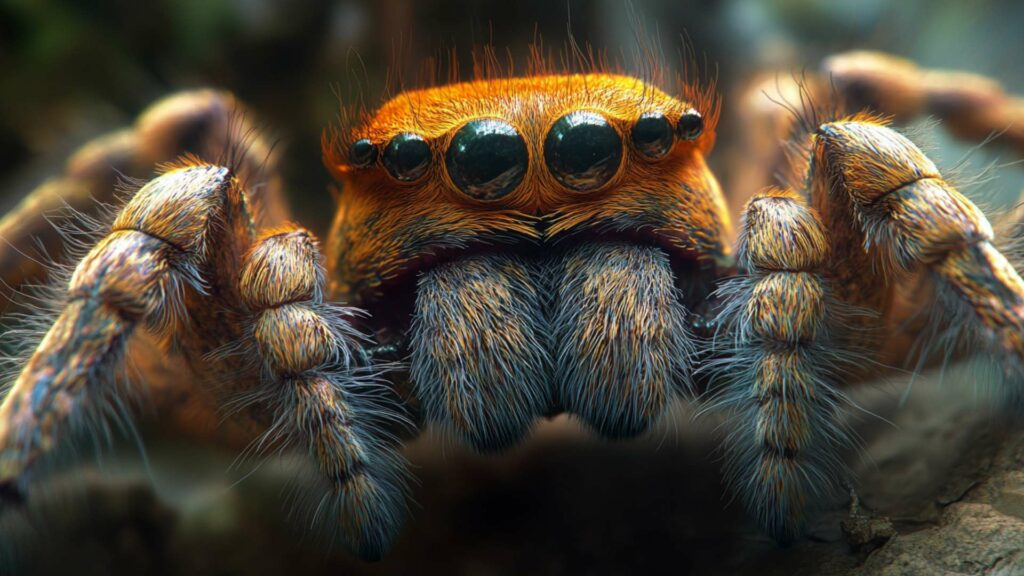
To truly understand how spiders perceive the world visually, we must acknowledge that not all spider species possess excellent eyesight like we do. Some spiders have adapted to low light conditions since they are primarily active during nighttime or reside in dark environments like caves or burrows.
This brings us to the intriguing question: do these cave-dwelling spiders have night vision? The answer lies within the complexity of spider vision itself.
While spiders don’t have the same color vision as humans, they excel at detecting movement. This ability is crucial for hunting, as it allows them to spot potential prey and pounce with impressive precision.
However, when it comes to seeing in low light conditions or complete darkness, not all spider species are created equal. Some have adaptations that grant them an advantage in these conditions, while others may rely on alternative senses such as touch or vibrations to find their prey.
Spiders’ Compound Eyes
When it comes to spiders, their eyes are truly fascinating. Unlike humans, who possess a pair of large, complex eyes, spiders have what are known as compound eyes. These compound eyes consist of multiple smaller lenses called ommatidia.
Each ommatidium captures a small portion of the visual field, and all of them together form a mosaic-like structure on the surface of the spider’s head. The number of ommatidia can vary among different spider species, ranging from just a few hundred to several thousand.
Role of Photoreceptor Cells
Within each ommatidium lies photoreceptor cells that play a crucial role in spider vision. These specialized cells are responsible for detecting light and converting it into electrical signals that can be processed by the spider’s nervous system.
Interestingly, studies have shown that spider photoreceptor cells are more sensitive to ultraviolet (UV) light compared to humans. This means that while we may not perceive certain UV patterns or colors in our surroundings, many spiders can see them vividly.
Differences from Human Eyes
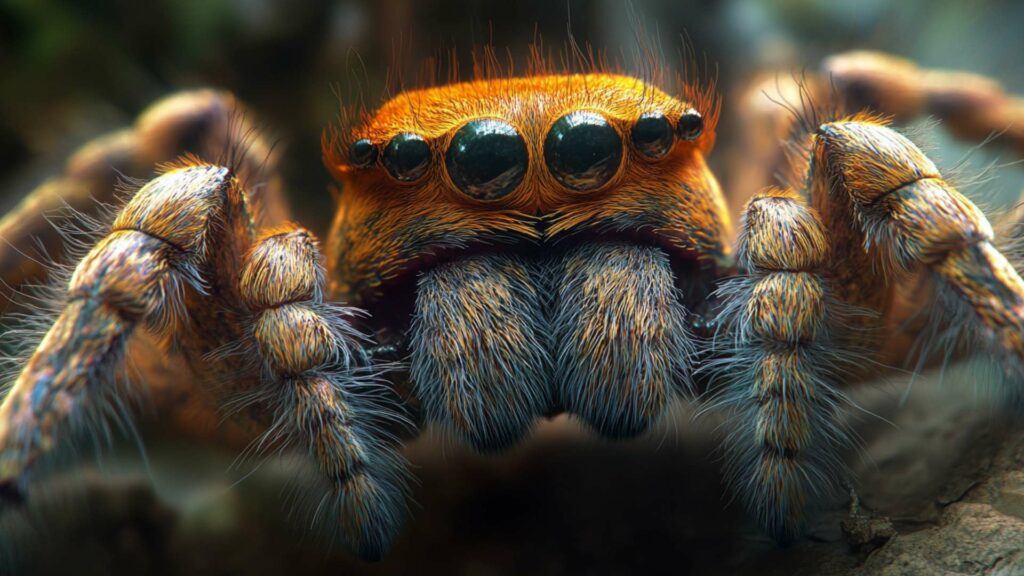
The differences between the vision capabilities of spiders and humans extend beyond just their eye structures. Spiders have evolved to prioritize motion detection rather than color perception like us humans.
This is because for many spiders, detecting prey or predators in their environment is crucial for survival and reproduction. While some spider species like jumping spiders have relatively larger eyes with better vision acuity compared to others, most spiders rely on other sensory organs such as touch or vibrations through their webs to navigate dark places.
Understanding spider vision basics helps unravel the mysteries behind these fascinating creatures’ unique visual systems. Their compound eyes composed of numerous ommatidia provide them with an incredible mosaic-like perspective on the world around them.
With their photoreceptor cells specifically attuned to detect UV light, spiders have a different visual and light spectrum, than humans. Furthermore, their focus on motion detection rather than color perception showcases the remarkable adaptations these arachnids have developed to thrive in dark places and find prey.
Spider night vision abilities
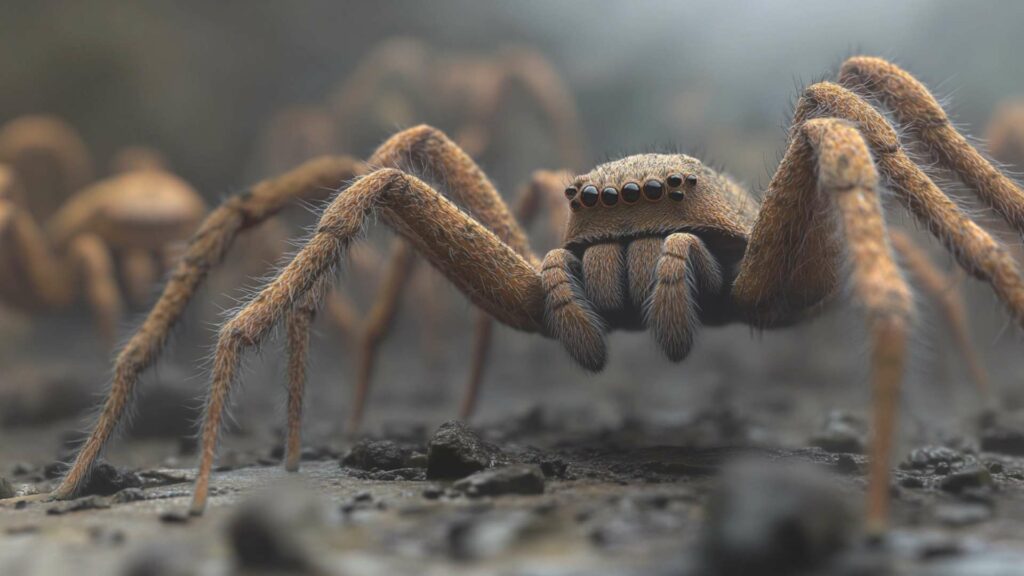
Spiders, often associated with their intricate and captivating webs, are primarily nocturnal hunters. When the sun goes down and darkness cloaks the world, these eight-legged predators awaken from their daytime slumber to embark on their nightly quests in search of food. While some species of spiders are active during the day, most thrive under cover of darkness.
This behavior allows them to take advantage of the reduced visibility among potential prey, giving them a competitive edge in finding sustenance. From dark caves to moonlit meadows, spiders tirelessly explore their surroundings with a keen sense of night vision.
Adaptations for low-light conditions
To navigate through dimly lit environments and locate their next meal, spiders have evolved remarkable adaptations that enable them to perceive the world around them even under challenging lighting conditions. Unlike humans who rely on color vision for visual recognition, most species of spiders possess very poor eyesight when it comes to distinguishing colors.
Instead, they excel at detecting motion and light intensity changes in their immediate vicinity. At first glance, spider eyes may appear simple compared to those of vertebrates like us.
However, these multifaceted creatures have developed various mechanisms that allow them to excel in low-light environments. Their large lenses and retinas help gather as much available light as possible while also enhancing visual acuity.
Moreover, some spider species possess a structure called tapetum lucidum—a reflective layer situated behind the retina—that aids in capturing and amplifying incoming light within the eye itself. In addition to physical adaptations within their eyes, spiders also utilize behavioral strategies for optimal night vision during hunting expeditions.
They carefully select locations for constructing their webs or burrows based on factors such as moonlight or starlight availability. By positioning themselves strategically where ambient light is maximized or reflecting off prey caught in their webs, they can effectively detect and capture unsuspecting victims.
This resourcefulness ensures that spiders make the most of the limited light available to them in their nocturnal pursuits. Overall, while spiders may not possess the same excellent vision and color discrimination as humans, they compensate for it with a remarkable ability to navigate through darkness.
Their adaptations for low-light conditions, such as their nocturnal hunting habits and behavioral strategies, ensure that these fascinating creatures are well-equipped to find prey even when light is scarce. Whether it’s the ultraviolet light guiding them to nectar-rich flowers or their keen perception of motion aiding in locating potential meals, spiders continue to astound us with their ingenuity and reliance on senses beyond what our own eyes can perceive.
Mechanisms of Spider Night Vision
Tapetum Lucidum in Some Species
One fascinating mechanism that scientists discovered enables spiders to have night vision is the presence of a specialized layer called the tapetum lucidum. This reflective layer is located behind the retina in certain species of spiders, allowing them to amplify incoming light and enhance their ability to see in low-light conditions.
The tapetum lucidum acts as a mirror, reflecting light back through the retina, essentially giving spider eyes a second chance to capture any missed photons. This adaptation greatly enhances their light sensitivity at night, making them formidable nocturnal hunters.
Reflective Layer Behind the Retina
The reflective layer found in spider eyes works the same way by bouncing incoming light back onto photoreceptor cells located within the retina. These photoreceptor cells are responsible for detecting light and converting it into electrical signals that can be interpreted by the spider’s nervous system. By reflecting and redirecting any available light towards these cells, spiders can effectively increase their chances of capturing even the faintest traces of illumination during dark hours.
Enhances Light Sensitivity at Night
Having a tapetum lucidum greatly enhances a spider’s visual capabilities in low-light conditions. This adaptation allows spiders to perceive and respond to stimuli that would otherwise be imperceptible to creatures with poor eyesight in darkness.
By maximizing their sensitivity to dim light, spiders gain an advantage when it comes to locating potential mates, finding prey, or evading predators under cover of night. It’s worth noting that while having a tapetum lucidum is common among nocturnal animals such as cats and dogs, not all species of spiders possess this feature.
Some other types rely on different adaptations for night vision based on variations in their eye structures or behavioral patterns. Understanding these mechanisms not only contributes to our knowledge of spider biology but also deepens our appreciation for the diverse ways in which different species have adapted to their unique ecological niches.
Large lenses and retinas
Spiders, with their incredible ability to see in the dark, possess a range of eye adaptations that aid them in their nocturnal endeavors. One key adaptation lies in the size of their lenses and retinas.
Unlike our own eyes that have relatively small lenses, spider’s eyes have large lenses that allow them to gather as much light as possible. These larger lenses act like tiny windows into the world around them, enabling them to make the most of the limited available light in their dark habitats.
In addition to larger lenses, spiders also have relatively large retinas. The retina is responsible for capturing light and converting it into electrical signals that can be processed by the brain.
With larger retinas, spiders are capable of gathering even more light and enhancing their visual acuity in low-light conditions. This high sensitivity to light allows them to navigate effectively during nighttime hunts.
Gathering more light
The primary purpose behind a spider’s large lenses and retinas is to maximize their ability to gather as much available light as possible for good vision. This adaptation is crucial for spiders since they rely heavily on visual cues when hunting for prey in dark places. By collecting an ample amount of incoming light through their eyes, these creatures can increase the chances of detecting subtle movements or unexpected prey activity even under minimal lighting conditions.
Moreover, this ability is particularly advantageous for hunting spiders like the jumping spider, spiders who possess exceptional eyesight compared to many other spider species. With these large lenses and retinas functioning at full capacity, jumping spiders can efficiently scan their surroundings for any potential prey or threats lurking nearby.
Enhanced visual acuity
Spider vision is remarkable not only because they can see in dim lighting but also due to their enhanced visual acuity in such conditions. The combination of large lenses and retinas allows spiders to capture and process even minute details in their environment with poor vision, enabling them to detect movement with incredible precision. This heightened visual acuity gives spiders an edge when it comes to identifying small insects or even other spiders, which might otherwise go unnoticed.
For instance, jumping spiders, renowned for their very good eyesight, rely heavily on their enhanced visual acuity during nighttime hunts. These agile hunters can spot tiny prey items crawling amidst the darkness and precisely plan their leaps to capture them.
Their remarkable vision enables them to navigate complex environments while avoiding potential predators or competitors. Spider-eye adaptations for night vision are truly fascinating.
Spiders’ large lenses and retinas allow them to gather more light, enhancing their ability to see in the dark. This increased sensitivity aids in capturing subtle movements and detecting prey effectively.
Additionally, this adaptation contributes to spiders’ enhanced visual acuity and plays a vital role in species such as jumping spiders that possess exceptional eyesight for hunting at night. The marvels of spider vision continue to astound us as we uncover the intricacies behind their unique adaptations in various light spectra.
Specialized Eye Structures for Night Vision
Spiders possess a fascinating adaptation in their eyes that allows them to excel in low-light conditions, such as during nighttime hunting. While humans rely heavily on our color vision during the day, spiders have evolved unique arrangements of photoreceptor cells that provide increased sensitivity to dim light.
Unlike our human eyes, which contain cone cells responsible for color vision in bright light and rod cells for black-and-white vision in dim light, spiders have an abundance of rod-like cells called rhabdoms. These specialized photoreceptor cells are highly sensitive to even the faintest traces of light, enabling spiders to detect prey and navigate effectively during nighttime hours.
Moreover, the arrangement of these rhabdoms in a spider’s principal eyes further enhances their ability to see in the dark. Most spiders have eight principal eyes arranged in two rows on the front of their head.
The median eyes, located at the center of these rows, play a crucial role in night vision due to their larger size and increased concentration of rhabdoms. This unique arrangement allows spiders to gather as much available light as possible through their small lenses and direct it towards these specialized cells for excellent vision even under starlit or moonlit skies.
Improved Detection of Motion: A Spider’s Advantage
In addition to heightened sensitivity to dim light, another remarkable aspect of spider night vision is their exceptional ability to detect motion. Spiders’ specialized eye structures enable them not only to see well at night but also accurately perceive movements around them.
While our human eyes struggle with tracking fast-moving objects or creatures in low-light conditions, spiders have evolved adaptations that give them an advantage when it comes to detecting movement. The specific arrangement and orientation of photoreceptor cells within a spider’s principal eyes contribute to their superior motion detection capabilities.
These cells are highly sensitive to changes in light intensity, which allows spiders to quickly detect the subtlest movements of potential prey or predators. This heightened sensitivity, coupled with their exceptional visual acuity, makes spiders efficient and formidable nocturnal hunters, capable of seizing opportunities in the darkness that other creatures might miss.
Adaptations for Survival: The Spider’s Nocturnal Advantage
Spiders’ specialized eye structures for night vision provide them with distinct advantages when it comes to survival and capturing prey. Their ability to see well in low-light conditions enables them to exploit the cover of darkness effectively and take advantage of unsuspecting insects or other small creatures during nighttime hours.
This adaptation is especially crucial for spider species that are primarily active at night or dwell in dark environments such as caves. By having a unique arrangement of photoreceptor cells that maximizes their sensitivity to dim light and enhances motion detection capabilities, spiders have developed a remarkable nocturnal advantage.
This evolutionary trait allows them not only to build complex webs precisely where they’ll be most effective but also detect any disturbances promptly—whether it be an approaching meal or a potential threat. These adaptations showcase the incredible diversity and ingenuity found in nature’s creations, reminding us once again of the marvels hidden within the world of spider vision.
Web Placement and Construction: Optimal Positioning for Prey Capture
When it comes to hunting during the night, spiders have mastered the art of strategic web placement and construction. These eight-legged marvels know that location is everything. Many species choose areas where insects are more likely to be found, such as near light sources, around vegetation, or close to bodies of water.
By selecting these prime spots for their webs, spiders increase their chances of trapping unsuspecting prey. But it’s not just about finding a suitable spot; spiders also pay meticulous attention to web design.
The silk they use is incredibly versatile, enabling them to create intricate patterns tailored to specific hunting needs. Some spiders weave orb-shaped webs that are perfectly designed for catching flying insects in mid-air.
These delicate structures often have sticky threads radiating from the center, acting like an invisible net waiting patiently for a meal to fly into its trap. Other species construct sheet-like webs stretched across plants or between surfaces with a tight line tension that ensures swift immobilization upon contact.
Utilizing Moonlight and Starlight
While some nocturnal animals prefer complete darkness due to very poor eyesight or being completely blind at night, spider vision has evolved differently. Spiders rely heavily on their other senses in conjunction with their specialized eyesight adaptations to navigate and hunt in low-light conditions effectively. One clever strategy these arachnids employ is utilizing moonlight and starlight as sources of illumination for improved vision during nighttime hunting expeditions.
Moonlight provides an ambient glow that allows spiders with good eyesight or specialized night vision adaptations like tapetum lucidum (reflective layer behind the retina) to detect potential prey more easily. Additionally, some spider species can perceive ultraviolet light (UV) emitted by stars and celestial bodies invisible to our naked eyes.
This ability allows them to navigate and orient themselves better in the darkness, making them formidable hunters even on the darkest nights. It’s fascinating to think about these creatures relying on celestial cues like tiny astronomers in the animal kingdom.
Spiders have developed remarkable behavioral adaptations for night hunting. They strategically position their webs, taking advantage of prime locations and utilizing specialized web designs to maximize prey capture.
Moreover, these resourceful arachnids harness the ambient glow of moonlight and even perceive invisible UV light from stars to enhance their night vision capabilities. Through these adaptations, spiders showcase their impressive precision in constructing a well-placed trap and using all available sensory organs to thrive in the dark corners of our world.
Species-specific variations in spider night vision
Wolf spiders and their keen night vision
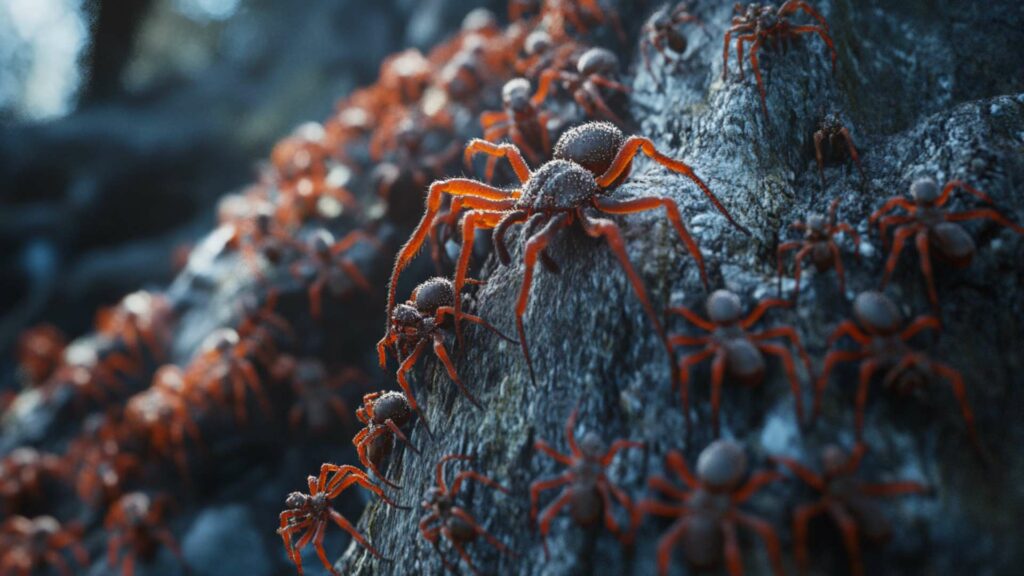
Unleashing the hunters of the moonlit darkness When it comes to mastering the art of nocturnal hunting, few spiders can rival the cunning prowess of wolf spiders.
With their distinctive eye arrangement and unique adaptations, these arachnid predators have evolved an exceptional ability to navigate and thrive in the dark environment. Unlike most spiders, which have very poor eyesight, wolf spiders possess a set of eight eyes that grant them an advantage when prowling under the cover of night.
One fascinating adaptation contributing to wolf spiders’ night vision is their reflective tapetae. Situated behind their retinas, these specialized structures enhance their ability to detect motion in low-light conditions.
The tapetae act like mirrors, reflecting incoming light back through the retina, effectively giving photoreceptor cells a second chance to capture as much available light as possible. This remarkable trait allows wolf spiders to make optimal use of even minimal ambient light sources such as moonlight or starlight.
When it comes to hunting strategies in darkness, wolf spiders exhibit remarkable resourcefulness and adaptability. Their acute night vision combined with their agile bodies enables them to swiftly pursue prey without relying solely on web construction like other hunting spider species.
Instead, they rely on stealthy approaches and lightning-fast reactions while relying on their exceptional visual acuity in near-darkness conditions. This unique combination of attributes turns them into skilled predators capable of ambushing unsuspecting insects or other small creatures that cross their path.
While most spiders suffer from poor eyesight during nighttime hours, wolf spiders stand out with their remarkable adaptations for navigating and hunting effectively in dark environments. Their arrangement of eight eyes coupled with reflective tapetae gives them a distinct advantage over other creatures occupying the same ecological niche.
Their agile bodies and acute night vision make them true masters of moonlit hunts. Witnessing the resourcefulness and precision of these arachnid hunters is a vivid reminder of the spectacular diversity that nature has bestowed upon us.
Limitations of spider night vision
Inability to see colors at night
While spiders possess remarkable abilities when it comes to navigating the darkness, their night vision is not without its limitations. One significant constraint is their inability to perceive colors during nocturnal activities. Unlike humans and many insects that rely on color vision for various tasks, spiders primarily rely on other senses and visual cues to find and capture prey.
This limitation stems from the structure of their eyes and the reduced availability of light in the dark. Spiders have evolved with a visual system geared towards detecting movement rather than discerning colors.
Their eyes are equipped with specialized photoreceptor cells that excel in low-light conditions but lack the necessary structures for color perception. Consequently, spiders navigate through the night with a grayscale perception of their surroundings.
Vulnerability to bright lights
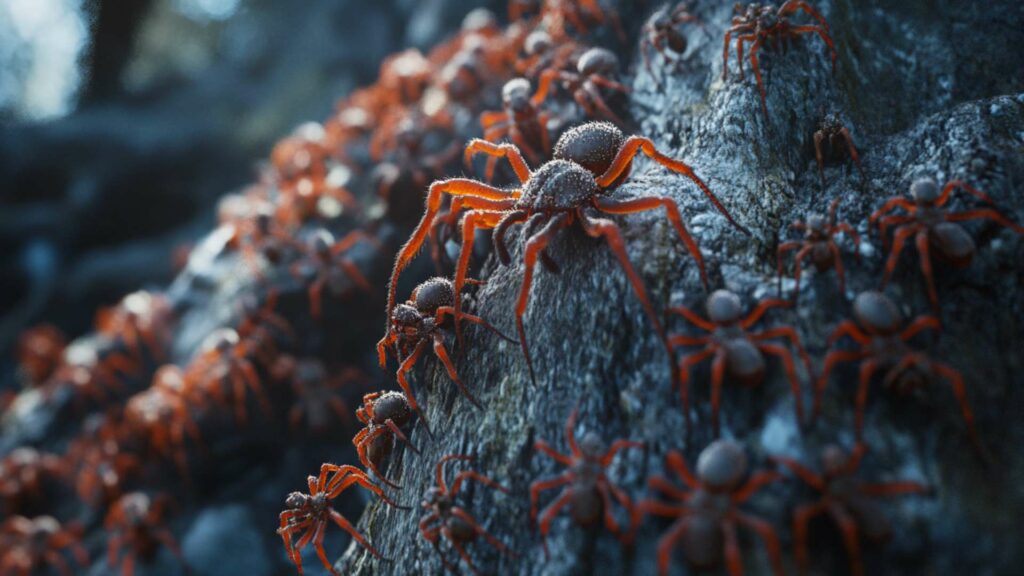
Another limitation of spider night vision lies in their vulnerability to bright lights. While they excel at hunting under dimly lit conditions, sudden exposure to intense light can temporarily impair their ability to see clearly or even disorient them. This vulnerability is particularly evident in species with more sensitive eyes, such as cave-dwelling spiders or those adapted for life in darker environments.
When exposed to bright lights, spiders may become temporarily blinded or lose focus due to an overwhelming flood of stimuli. For instance, a common house spider may retreat instinctively upon encountering a flashlight beam shining directly into its eight eyes.
This reaction is not indicative of poor eyesight but rather serves as a defense mechanism against potential harm. While spiders possess remarkable adaptations for nocturnal activities and navigating low-light environments, there are limitations they face in terms of color perception and susceptibility to bright lights.
Their visual system prioritizes motion detection over color vision due to the specialized structures within their compound eyes. Understanding these limitations can further deepen our appreciation for the diverse ways in which different species interact with their environments.
Conclusion
As we delve into the intricate world of spiders and their remarkable abilities, it is impossible not to be astounded by their adaptations. The spider’s head, adorned with its eight eyes, is a testament to nature’s ingenuity.
From the primary eyes that provide excellent vision in daylight to the secondary eyes that help them navigate in low light conditions, these sensory organs are nothing short of awe-inspiring. Consider the common house spider, weaving its delicate web with precision and patience.
Its primary eyes allow it to detect vibrations on its web with pinpoint accuracy, ensuring a successful catch every time. And let us not forget flower spiders, whose colorful bodies and keen sight make them masters of camouflage as they patiently wait for their unsuspecting prey.
Spiders live among us in an astonishing array of shapes and sizes, each tailored to fit their unique evolutionary niche. From tiny jumping spiders with their oversized eyes and acrobatic moves to wolf spiders equipped with very good night vision for nocturnal hunting expeditions, these creatures have adapted to thrive in diverse environments.
Their visual systems offer a fascinating glimpse into how nature has equipped them for survival. While most spiders rely on excellent eyesight for hunting during the day or under bright lights, others have evolved specialized structures like reflective tapetae or unique arrangements of photoreceptor cells to excel in low-light conditions.
In appreciating the diversity of nature’s creations like spiders, we gain a deeper understanding of our own place within this intricate tapestry called life. It reminds us that there is an inherent beauty in every living organism and encourages us to approach our surroundings with curiosity and respect.
So next time you spot a spider scurrying across your wall or spinning an intricate web outside your window, take a moment to marvel at its adaptations and appreciate the incredible diversity of the natural world. There is so much to learn and explore, and by doing so, we not only deepen our connection with nature but also nurture a sense of wonder that enriches our own lives.
Vanquish spiders using D-Termination: The top-notch Pest Control choice in Las Vegas!

Anxious over spider presence in your Las Vegas property? Turn to D-Termination for the answer. Our team of skilled professionals is specialized in eradicating spider infestations, bringing back serenity and calm to your environment. Bid adieu to spiders—opt for D-Termination’s efficient pest control services today!
Reach us at 702-919-6310 or explore dtermination.com to arrange your spider control service and take back your space from these bothersome pests.
Frequently Asked Questions:
Nocturnal spiders often have enhanced night vision.
Spiders can detect movement and shapes at night but may not “see” like humans.
Many spiders are active in the dark due to their nocturnal nature.
Spiders seek shelter in various hidden spots during the dark hours.








